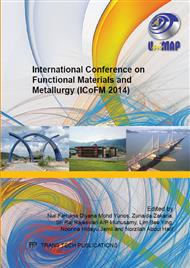[1]
N.N. Bonnia, M. M Mahat., S.N. Surip, H. Anuar, N.A. Hassan and S. Ahmad (2012). Polyester/ Kenaf Composite; Effect of Matrix Modification. IEEE., pp.518-522.
DOI: 10.1109/isbeia.2012.6422940
Google Scholar
[2]
A.S. Singha and K. Ashvinder (2012). Effect of graft copolymerization on mechanical, thermal and chemical properties of Grewia optiva/ unsaturated polyester composites. Polymer Composites 33: 1403-1414.
DOI: 10.1002/pc.22267
Google Scholar
[3]
M. Y Yuhazri, P.T. Phongsakorn, S. Haeryip (2010). A comparison process between vacuum infusion and hand lay-up method toward kenaf/ polyester composites. International Journal of Basic and Applied Sciences 10(3): 54-57.
Google Scholar
[4]
R.T. Woodhams, G. Thomas and D.K. Rodgers (1984). Woods fibres as reinforcing fillers for polyolefins. Polymer Engineering and Science 24: 1166.
DOI: 10.1002/pen.760241504
Google Scholar
[5]
G.E. Myers, C.M. Clemons, J. J Balatinecz and R.T. Woodhams (1992). Effects of composition and polypropylene-waste newspaper composites. Antec 92(1): 602-604.
Google Scholar
[6]
B.V. Kokta, R.G. Raj and C. Daneault (1989). Effect of fiber treatment on mechanical properties of polypropylene-wood fiber composites. Polymer-Plastics Technology and Engineering 28: 24.
DOI: 10.1002/masy.19890280113
Google Scholar
[7]
P.M. Tahir, A.B. Ahmed, S.O.A. Saiful Azry and Z. Ahmed (2011). Retting process of some bast plant fibers and its effect on fiber quality: a review. BioResources 6(4): 5260-5281.
DOI: 10.15376/biores.6.4.5260-5281
Google Scholar
[8]
W.H. Morrison III, D.D. Archibald, H.S.S. Sharma and D.E. Akin (2000). Chemical and physical characterization of water and dew retted flax fiber. Industrial Crops and Products 12: 39-46.
DOI: 10.1016/s0926-6690(99)00044-8
Google Scholar
[9]
R.M. Taib, S. Ramarad, Z.A.M. Ishak and M. Todo, (2010). Properties of kenaf fiber/ polylactic acid biocomposites plasticized with polyethylene glycol. Polymer Composites 31(7), 1214-1222.
DOI: 10.1002/pc.20908
Google Scholar
[10]
S. Ozturk (2010). Effect of fiber loading on the mechanical properties of kenaf and fiberfrax fiber-reinforced phenol–formaldehyde composites. Journal of Composite Materials 44, 2265–2288.
DOI: 10.1177/0021998310364265
Google Scholar
[11]
A.E. Elsayed, S.A. Mohamed and H. Hamada. Mechanical properties of natural jute fabric/ jute mat fibre reinforced polymer matrix hybrid composites. Advances in Mechanical Engineering 2012; 2-12.
DOI: 10.1155/2012/354547
Google Scholar
[12]
A.K. Mohanty, M. Misra, L.T. Drzal (2005). Natural Fibers, Biopolymers and Biocomposites. Florida: CRC Press.
DOI: 10.1201/9780203508206.ch1
Google Scholar


